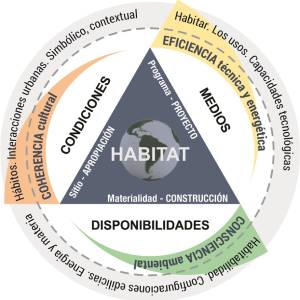Reviews for a situated, appropriate and sustainable contemporary design education
DOI:
https://doi.org/10.35305/23626097v11i21.485Keywords:
training, design thinking, design, sustainability, architectureAbstract
The paper is presented as a descriptive-interpretive inquiry in the field of contemporary design education to reflect on the knowledge and qualities that are relevant to situated, appropriate and sustainable teaching developments. To achieve this end, design education is characterized, transition from design thinking to sustainable design thinking is postulated, arguments and experiences of sustainable design training are described, and integrative reflections are established. Finally, it is concluded that the design focus shifts from how and what to why, thereby reducing the value of individually made artifacts and reinforcing the prominence of the foundations. This is based on research, ethical positioning and group care. Thus, the teaching-learning process is enabled and oriented to both the current characteristics and demands of the local-global context and the reinforcement of personal qualities to define the complex design problematic situations and their consequent proposals with cultural coherence, technological efficiency and environmental awareness.
Downloads
Metrics
References
Breyer, G. (2007). Heurística del diseño. Buenos Aires, Argentina: Ediciones FADU.
Brundtland, G. H. (1987). Our common Future. Oxford, UK: Oxford University Press.
Burgos, C. (2016) La construcción del conocimiento proyectual en el diseño arquitectónico: dimensiones cognoscitivas y epistémicas implicadas en el proceso educativo. ADNea (4). https://doi.org/10.30972/adn.042258
Cravino, A. (2019). Enseñar Diseño: La emergencia de la teoría. Cuadernos del Centro de Estudios de Diseño y Comunicación, (67), 163-185. https://doi.org/10.18682/cdc.vi67.1135
Cravino, A. y Pokropek, J. (2024). Construcción de conocimiento en diseño. Los desafíos de la investigación disciplinar. Cuadernos del Centro de Estudios de Diseño y Comunicación, (226). https://doi.org/10.18682/cdc.vi226.11303
Davis, M. y Dubberly, H. (2023). Rethinking Design Education. She Ji: The Journal of Design, Economics, and Innovation, Vol. 9 (2). 97-116. https://doi.org/10.1016/j. sheji.2023.04.003.
Doberti, R. (2006). La cuarta posición. Buenos Aires, Argentina: FADU, UBA.
Fernández, R. (2012). Arquitectura y ciudad: del proyecto al eco-proyecto. Buenos Aires, Argentina: Nobuko.
Fernández, R. (2020a). Didáctica y Proyecto: Divergencias y convergencias entre profesión y disciplina. Registros, Vol. 16 (1). 4-17. https://revistasfaud.mdp.edu.ar/registros/article/view/424
Fernández, R. (2020b) Teoría e historia del proyecto arquitectónico y urbano. Documento de cátedra en el marco del Doctorado en Arquitectura y Urbanismo, UAI-UCU-UFLO.
Fernández, J. L., Vecchi, R. y Rosello, B. (2019). Taller de Arquitectura Sur. Propuesta pedagógica/ académica, Carrera de Arquitectura, DGyT-UNS. Bahía Blanca, Argentina.
Foqué, R. (2010). Building Knowledge in Architecture. Bruselas, Bélgica: University Press Antwerp.
Friedman, K. (2012). Models of Design: Envisioning a Future Design Education. Visible Language, 46, 132-153. https://journals.uc.edu/index.php/vl/article/view/5859
Lattuca, A. P. (2006). Arquitectura sustentable. Una forma de diseño y construcción éticamente responsable. Avances en Energías Renovables y Medio Ambiente. ASADES INENCO, 10.
Noel, L., Ruiz, A., van Amstel, F., Udoewa, V., Verma, N., Kommey Botchway, N., Lodaya, A. y Agrawal, S. (2023). Pluriversal Futures for Design Education. She Ji: The Journal of Design, Economics and Innovation, 9(2), 179-196. https://doi.org/10.1016/j.sheji.2023.04.002
Organización de las Naciones Unidas (2018). La Agenda 2030 y los Objetivos de Desarrollo Sostenible: una oportunidad para América Latina y el Caribe. Santiago de Chile, Chile: CEPAL. https://hdl.handle.net/11362/40155
Rodríguez, L. G. (2020). La evaluación formativa en Arquitectura. Aportes para la enseñanza desde la formación integral en los talleres FAU, UNLP (Tesis doctoral) FAU UNLP. https://doi.org/10.35537/10915/127714
Rodríguez, L. G. (2022). Nuestra didáctica para el saber proyectual. Cuadernos del Centro de Estudios de Diseño y Comunicación, (175). https://doi.org/10.18682/cdc.vi175.8605
Rodríguez, L. G. (2023). Acuerdos epistemológicos para el saber proyectual. AREA, 29(1), 1-9. https://publicacionescientificas.fadu.uba.ar/index.php/area/article/view/2096
Rodríguez, L. G. (2024). Rémoras de un pasado presente: Revisando inercias de la modernidad en la educación proyectual del siglo XXI. Cuadernos del Centro de Estudios en Diseño y Comunicación, 231, 87-104. https://doi.org/10.18682 cdc.vi231
Rodríguez, L. G. y Fernández, J. L. (2024) Study of energy and technological categories of building, for comprehensive training in the architectural design process. Journal of Research in Production and Development, 10(1), 1-15.
Rodríguez, L. G., Fiscarelli, D. y Fernández, J. L. (2022). Sustentabilidad tecnológico-energética en la arquitectura: Estrategias y reflexiones a partir de la vivienda compacta. Arquitecno, (20), 33–43. https://doi.org/10.30972/arq.0206257
Romano, A. M. (2015). Conocimiento y práctica proyectual. Buenos Aires, Argentina: Infinito.
Romano, A. M. (2021). Aprender [y enseñar] a proyectar arquitectura. Buenos Aires, Argentina: Diseño.
San Juan, G. (2013). Diseño bioclimático como aporte al proyecto arquitectónico. La Plata, Argentina: EDULP.
Simon, H. A. (1996). The Sciences of the Artificial. Cambridge, Massachusetts, UK/USA: MIT Press.
Ynoub, R. (2015). Cuestión de método. Aportes para una metodología crítica. Mexico D.F., México: Cengage Learning

Published
How to Cite
Issue
Section
License
Copyright (c) 2024 A&P Continuidad

This work is licensed under a Creative Commons Attribution-NonCommercial-ShareAlike 4.0 International License.
Open access policy
A&P Continuidad is a non-profit and open access publication. According to Mexico Declaration on Cultural Policies, the journal distribution is submitted to Creative Commons Attribution-Noncommercial-ShareAlike 4.0 International Public License (CC BY-NC-SA). “Neither the commercial use of the original work nor that of the possible derivative works are allowed. The distribution of derivative works should be submitted to the license regulating the original work. This license is not free.”
A&P Continuidad authorizes the partial or full reproduction of texts and graphs provided that the source is cited. Authors are exclusively responsible for the criteria expressed in the articles which do not necessarily reflect the opinion of the Editorial Committee or that of the Direction Board. The copyright of the published articles pertains to their authors or publishers.
Transfer of rights
The acceptance of an article to be published implies the author’s transfer of rights to the journal. Authors continue to have the right to use the material in future books or publications, approve or veto the republication of their works as well as the rights related to patents or other rights. Transfer of rights form may be downloaded here.























 This OJS site and its metadata are under a
This OJS site and its metadata are under a 

